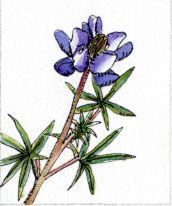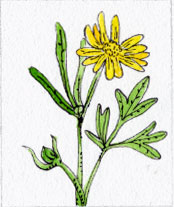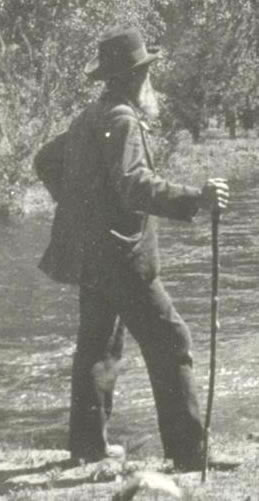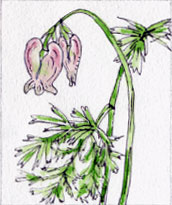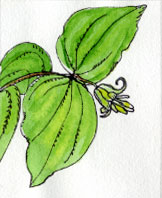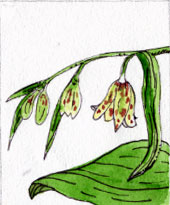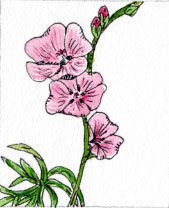IV. San Joaquin Valley
A letter to bro David: July 1868:
A letter to the Merrills: July 1868:
A letter to Mrs. Carr: July 1868
...The valley of the San Joaquin is the floweriest piece of world I ever walked, one vast level, even flower-bed, a sheet of flowers, a smooth sea ruffled a little by the tree fringing of the river and here and there of smaller cross streams from the mountains. Florida is indeed a land of flowers, but for every flower creature that dwells in its most delightsome places more than a hundred are living here. Here, here is Florida. Here they are not sprinkled apart with grass between, as in our prairies, but grasses are sprinkled in the flowers; not, as in Cuba, flowers piled upon flowers heaped and gathered into deep, glowing masses, but side by side, flower to flower, petal to petal, touching but not entwined, branches weaving past and past each other, but free and separate, one smooth garment, mosses next the ground, grasses above, petaled flowers between.
Before studying the flowers of this valley, and their sky and all of the furniture and sounds and adornments of their home, one can scarce believe that their vast assemblies are permanent, but rather that, actuated by some plant purpose, they had convened from every plain, and mountain, and meadow of their kingdom, and that the different coloring of patches, acres, and miles marked the bounds of the various tribe and family encampments. And now just stop and see what I gathered from a square yard opposite the Merced. I have no books and cannot give specific names:--
Orders Open flowers Species
Compositae 1 32,125 2 yellow, 3305 heads
Leguminosae 2620 2 purple and white
Scrophulariaceae 169 1 purple
Umbellaccae 620 1 yellow
Geraniaceae 22 1 purple
Rubiaceae 40 1 white
85 Natural order unknown
60 Plants unflowered
Polemoniacae 407 2 purple
Gramineae 29,830 ; stems about700; spikelets 10,700
Musci 10,000,000 2 purples, Dicranum, Tunar
Total of open flowers, 165,912
flowers in bud, 100,000
withered, 40,000
natural orders, 9-11
species, 16-17
mosses, 1,000,000
The yellow of these Compositae is extremely deep and rich and bossy, as though the sun had filled their petals with a portion of his very self. It exceeds the purple of all the others in superficial quantity forty or fifty times their whole amount, but to an observer who first looks downward and then takes a more distant view, the yellow gradually fades and purple predominates because nearly all of the purple flowers are higher. In depth the purple stratum is about ten or twelve inches, the yellow seven or eight, and second purple of mosses one.
I'm sorry my page is done. I have not told anything. I thought of you, Mrs. Carr, when I was in the glorious Yosemite and of the prophecy of "the Priests," that you would see it and worship there with your Doctor and Priest and I. It is by far the grandest of all of the special temples of Nature I was ever permitted to enter. It must be the sanctum sanctorum of the Sierras, and I trust that you will all be led to it.
Rambles of a Botanist: 1872
In half a day we were down over all the foot-hills, past the San Luis Gonzaga Ranch, and wading out in the grand level ocean of flowers. This plain, watered by the San Joaquin and Sacramento rivers, formed one flower-bed, nearly four hundred miles in length by thirty in width. In order that some definite conception may be formed of the richness of this flower-field, I will give a harvest gathered by me from one square yard of plain, opposite Hill's Ferry, a few miles from the coast range foot-hills, and taken at random, like a cupful of water from a lake. An approximation was made to the number of grass flowers by counting the panicles, to the flowers of the Compositae by counting the heads. The mosses were roughly estimated by counting the number growing on one square inch. All the flowers of the other natural orders were counted one by one.
Natural Orders no. of flowers no. of species.
Graminaceae....... 29,830 Panicles 1,000..................3
Compositae........ 132,125 Heads 3,305................. 2
Legunimosae....... 2,620 .........................................................2
Umbelliferae...... 620 .......................................................... 1
Polemoniaceae.. 401............................................................ 2
Scrophulariaceae 169 ...........................................................1
________? ... 85 ...........................................................1
Rubiaceae ..... 40 ..........................................................1
Geraniaceae..... 22 ..........................................................1
Musc...... 1,000,000 Funaria and Dicranum ........... 2
Number of natural orders, 9 to 10. Of species, 16.
Total number of open flowers, 165,912. Mosses, 1,000,000.
In the above estimate, only open living flowers were taken into account. Those which were still in bud, together with those that were past flower, would number nearly as many more. The heads of the Compositae are usually regarded as one flower. Even then we would have seven thousand two hundred and sixty-two flowers, together with a thousand silky, transparent panicles of grasses, and a floor an inch thick of hooded mosses. The grasses have scarce any leaves, and do not interfere with the light of the other flowers, or with their color, in any marked degree.
The yellow of the Compositae is pure, deep, bossy solar gold, as if the sun had filled their rays and flowerets with the undiluted substance of his very self. In depth, the purple stratum was about ten or twelve inches; the yellow, seven or eight, and the moss stratum, of greenish yellow, one. But the purple stratum is dilute and transparent, so that the lower yellow is hardly dimmed; and only when a horizontal view is taken, so as to look edgewise through the upper stratum, does its color predominate. Therefore, when one stands on a wide level area, the gold immediately about him seems all in all; but on gradually looking wider the gold dims, and purple predominates.
In this botanist's better land, I drifted separate many days, the largest days of my life, resting at times from the blessed plants, in showers of bugs and sun-born butterflies; or I watched the smooth-bounding antelopes, or startled hares, skimming light and swift as eagles' shadows; or turning from all this fervid life, contemplated the Sierras, that mighty wall uprising from the brink of this lake of gold, miles in the higher blue, bearing aloft its domes and spires in spotless white, unshining and beamless, yet pure as pearl, clear and undimmed as the flowers at my feet. Never were mortal eyes more thronged with beauty. When I walked, more than a hundred flowers touched my feet, at every step closing above them, as if wading in water. Go where I would, east or west, north or south, I still plashed and rippled in flower-gems; and at night I lay between two skies of silver and gold, spanned by a milky-way, and nestling deep in a goldy-way of vegetable suns. But all this beauty of life is fading year by year, - fading like the glow of a sunset, - foundering in the grossness of modern refinement. As larks are gathered in sackfuls, ruffled and blood-stained, to toy morbid appetite in barbarous towns, so is flower-gold gathered to slaughter-pens in misbegotten carcasses of oxen and sheep. So always perish the plant peoples of temperate regions, - feeble, unarmed, unconfederate, they are easily overthrown, leaving their lands to man and his few enslavable beasts and grasses. But vigorous flower nations of the South, armed and combined, hold plantfullly their rightful kingdom; and woe to the lordly biped trespassing in these tropic gardens; catbriers seam his flesh, and saw-palmettoes grate his bones, and bayonets glide to his joints and marrow. But, alas! here only one plant of this plain is armed; a tall purple mint, speared and lanced like a thistle. The weapons of plants are believed by some to be a consequence of "man's first disobedience. " Would that all the flowers of the Sacramento and San Joaquin, were "cursed, - " thorned and thistled in safety!
February and March is the ripe spring-time of the plain, April the summer, and May the autumn. The first beginnings of spring are controlled by the rains, which generally appear in December. Rains between May and December are very rare. This is the winter, - a winter of drought and heat. But in no part of the year is plant-life wholly awanting. A few lilies with bulbs very deep in the soil, and a rosy compound called tar-weed, and a species of erigonum, are slender, inconspicuous links which continue the floral chain from season to season around the year.
Ere we were ready to recommence our march to Yosemite, May was about half done. The flowers and grasses, so late in the pomp and power of full bloom, were dead, and their parched leaves crisped and crackled beneath our feet, as if they had literally been "cast into the oven." They were not given weeks and months to grow old; but they aged and died ere they could fade, standing side by side, erect and undecayed, bearing seed-cells and urns beautiful as corollas.
Pelican Bay Manuscript 1907:
1000 Mile Walk:
...The valley of the San Joaquin is the floweriest piece of world I ever walked, one vast, level, even flower-bed, a sheet of flowers, a smooth sea, ruffled a little in the middle by the tree fringing of the river and of smaller cross-streams here and there, from the mountains.
Florida is indeed a "land of flowers," but for every flower creature that dwells in its most delightsome places more than a hundred are living here. Here, here is Florida! Here they are not sprinkled apart with grass between as on our prairies, but grasses are sprinkled among the flowers; not as in Cuba, flowers piled upon flowers, heaped and gathered into deep, glowing masses, but side by side, flower to flower, petal to petal, touching but not entwined, branches weaving past and past each other, yet free and separate - one smooth garment, mosses next the ground, grasses above, petaled flowers between.
Before studying the flowers of this valley and their sky, and all of the furniture and sounds and adornments of their home, one can scarce believe that their vast assemblies are permanent; but rather that, actuated by some plant purpose, they had convened from every plain and mountain and meadow of their kingdom, and that the different coloring of patches, acres, and miles marks the bounds of the various tribes and family encampments.
note; At this point the journal ends. The remainder of this chapter is taken from a letter written to Mrs. Ezra S. Carr from the neighborhood of Twenty Hill Hollow in July, 1868.
Life and Letters: 1924
Crossing this greatest of flower gardens and the San Joaquin River at Hill's Ferry, we followed the Merced River, which I knew drained Yosemite Valley, and ascended the foothills from Snelling by way of Coulterville. We had several accidents and adventures. At the little mining town of Coulterville we bought flour and tea and made inquiries about roads and trails, and the forests we would have to pass through. The storekeeper, an Italian, took kindly pains to tell the pair of wandering wayfarers, new arrived in California, that the winter had been very severe, that in some places the Yosemite trail was still buried in snow eight or ten feet deep, and therefore we would have to wait at least a month before we could possibly get into the great valley, for we would surely get lost should we attempt to go on. As to the forests, the trees, he said, were very large; some of the pines eight or ten feet in diameter.
In reply I told him that it would be delightful to see snow ten feet deep and trees ten feet thick, even if lost, but I never got lost in wild woods. "Well," said he, "go, if you must, but I have warned you; and anyhow you must have a gun, for there are bears in the mountains, but you must not shoot at them unless they come for you and are very, very close up." So at last, at Mr. Chilwell's anxious suggestion, we bought an old army musket, with a few pounds of quail shot and large buckshot, good, as the merchant assured us, for either birds or bears.
Son of the Wilderness: 1946
The air was 'throbbing with lark song" as they struck off eastward from Gilroy toward Pacheco Pass. From this height Muir looked down upon "the floweriest piece of world" he had ever seen. Descending into it, he followed his own erratic pattern up and down the broad Central Valley as the flowers in their April glory led him. Finally, directed by his compass, he and the impatient Chilwell reached Hill's Ferry, by which they crossed the San Joaquin River; then they began the ascent of the Merced toward the Yosemite Valley.
